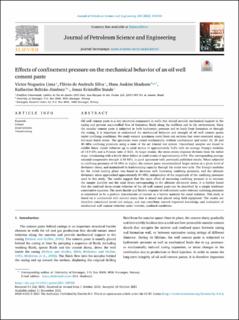| dc.contributor.author | Lima, Victor Nogueira | |
| dc.contributor.author | Silva, Flavio de Andrade | |
| dc.contributor.author | Skadsem, Hans Joakim | |
| dc.contributor.author | Beltran Jimenez, Katherine | |
| dc.contributor.author | Sunde, Jonas Kristoffer | |
| dc.date.accessioned | 2021-11-19T09:27:56Z | |
| dc.date.available | 2021-11-19T09:27:56Z | |
| dc.date.created | 2021-11-11T19:32:10Z | |
| dc.date.issued | 2021-11 | |
| dc.identifier.citation | Lima, V.N., Silva, F de A., Skadsem, H.J. et al. (2021) Effects of confinement pressure on the mechanical behavior of an oil well cement paste. Journal of Petroleum Science and Engineering, 109769 | en_US |
| dc.identifier.issn | 0920-4105 | |
| dc.identifier.uri | https://hdl.handle.net/11250/2830423 | |
| dc.description.abstract | Oil well cement paste is a key structural component in wells that should provide mechanical support to the casing and prevent uncontrolled flow of formation fluids along the wellbore and to the environment. Since the annular cement paste is subjected to both hydrostatic pressure and to loads from formation or through the casing, it is important to understand the mechanical behavior and strength of oil well cement pastes under confining conditions. We study cement specimens cored from test sections that were cemented using a full-scale batch mixer. The specimens were tested mechanically without confinement and under 10, 20 and 40 MPa confining pressures using a state of the art triaxial test system. Unconfined samples are found to exhibit linear elastic behavior up to axial strains of approximately 0.2% with an average Young’s modulus of 14.9 GPa and a Poisson ratio of 0.21. At larger strains, the stress–strain response deviates from the initial slope, terminating with a brittle shear failure at axial strains of approximately 0.5%. The corresponding average uniaxial compressive strength is 58 MPa, in good agreement with previously published results. When subjected to confining pressures of 10 MPa or higher, the cement paste accommodated larger strains at a given level of deviatoric stress, and maintained its load-carrying capacity through the entire test cycle. The Young’s modulus for the initial loading phase was found to decrease with increasing confining pressures, and the ultimate deviatoric stress approached approximately 80 MPa, independent of the magnitude of the confining pressures used in this study. The results suggest that the main effect of increasing confining pressure is to increase the sample ductility and the axial strain corresponding to the ultimate deviatoric stress. It is further found that the confined stress–strain behavior of the oil well cement paste can be described by a simple nonlinear constitutive equation. The more ductile and flexible response of well cement under relevant confining pressures is considered to be a positive characteristic of cement as a barrier material for zonal isolation. This study is based on a commercial well cement slurry that is mixed and placed using field equipment. The results are therefore considered novel and unique, and can contribute toward improved knowledge and evaluation of mechanical well cement behavior under realistic, confined conditions. | en_US |
| dc.language.iso | eng | en_US |
| dc.publisher | Elsevier Ltd. | en_US |
| dc.rights | Navngivelse 4.0 Internasjonal | * |
| dc.rights.uri | http://creativecommons.org/licenses/by/4.0/deed.no | * |
| dc.subject | petroleumsteknologi | en_US |
| dc.title | Effects of confinement pressure on the mechanical behavior of an oil well cement paste | en_US |
| dc.type | Peer reviewed | en_US |
| dc.type | Journal article | en_US |
| dc.description.version | publishedVersion | en_US |
| dc.rights.holder | © The Author(s) 2021 | en_US |
| dc.subject.nsi | VDP::Teknologi: 500::Berg‑ og petroleumsfag: 510::Petroleumsteknologi: 512 | en_US |
| dc.source.journal | Journal of Petroleum Science and Engineering | en_US |
| dc.identifier.doi | 10.1016/j.petrol.2021.109769 | |
| dc.identifier.cristin | 1953819 | |
| dc.relation.project | Norges forskningsråd: 308767 | en_US |
| dc.source.articlenumber | 109769 | en_US |
| cristin.ispublished | true | |
| cristin.fulltext | postprint | |
| cristin.qualitycode | 2 | |

